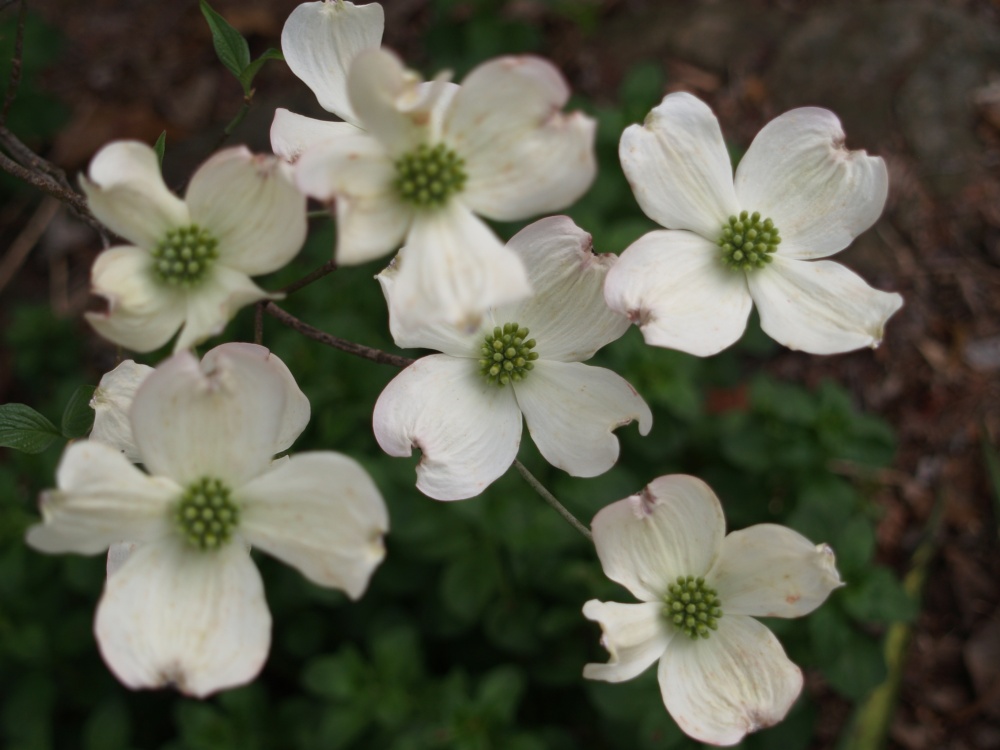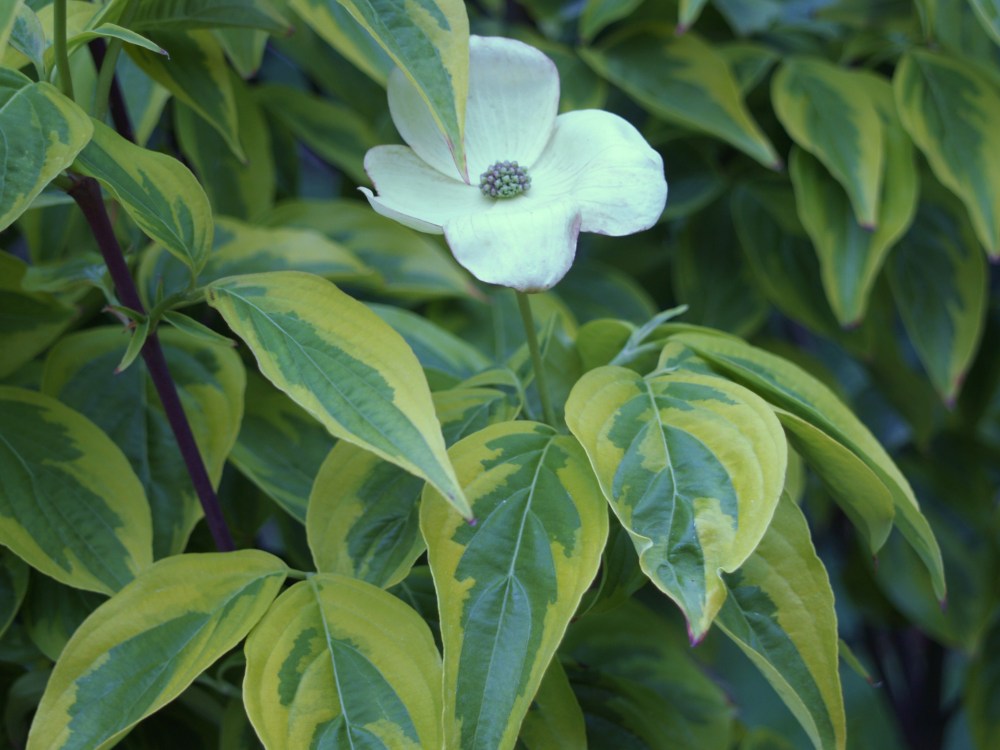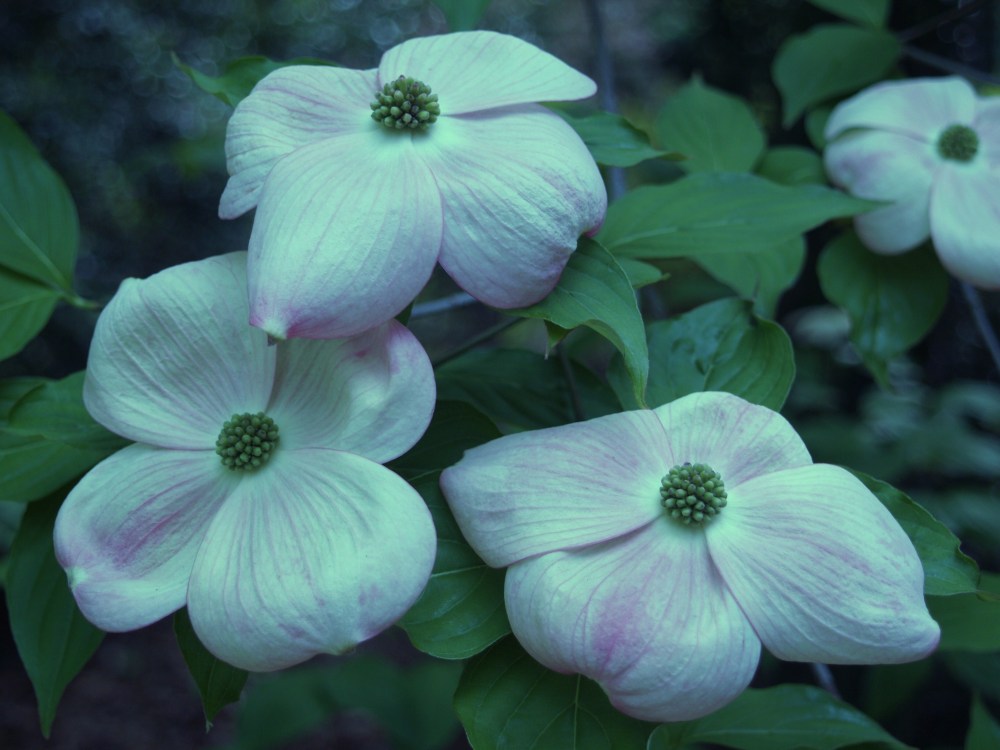The dogwood that is native to the eastern United States (Cornus florida, in bloom below) is a wonderful tree with beautiful large white flowers in early spring (actually white bracts that surround the small, undistinguished flowers), excellent autumn foliage color, and clusters of red berries that persist into early winter when birds pick them clean. Unfortunately, even improved selections of the native dogwood are susceptible to a variety of maladies that can disfigure or kill the tree. In my garden I’ve planted several dogwoods that suffer from moderate to severe leaf spotting (anthracnose) in wet springs, and powdery mildew in hot, muggy summers. While this is hardly cause for concern, two large dogwoods have various small and large cankers that will eventually spell their doom, though they’ve survived for twenty years so far, and I don’t regret planting them for a moment.
A variegated leaf selection of the native dogwood, ‘Cherokee Sunset’ (below) has splendid yellow and green foliage and red blooms, though it hasn’t flowered in my garden for the past five years (at least). Plants with colored and variegated foliage are often slower growing and less vigorous than the green leafed versions (due to less chlorophyll), and with dogwoods I believe this makes the tree less tolerant of foliar diseases. Though its foliage is beautiful through the spring, by mid summer I take for granted that ‘Cherokee Sunset’ will be covered in mildew, and I’m guessing this disturbs the tree in forming flower buds for the following spring.
Last year I planted several dogwoods with similar green and yellow variegation that are vigorous growers, and are resistant to the disease problems of the native. ‘Celestial Shadow’ (Cornus x ‘Celestial Shadow’, below) is a selection from the Rutgers University introduced hybrid dogwood ‘Celestial’, which is a cross between the native Cornus florida and the disease resistant Chinese dogwood (Cornus kousa). The native Cornus florida typically flowers in mid April in my garden (though it started in late March this year), and Cornus kousa usually begins to flower in late May, though sometimes it’s delayed into early June. The Rutgers’ hybrids flower right in the middle of the two parents, typically mid May, but this year the flowers are evident late in April.
The Chinese dogwoods (Cornus kousa) add vigor and disease resistance to the early flowering genetics of the native dogwood, but their form is often shrub like, and only a few selections grow taller than wide. Chinese dogwoods are usually low branched or multi trunked, and along with late spring flowers this helps explain why they are not more popular in American gardens. The Rutgers’ hybrids are fast growing, but their growth is more upright and tree like, and only after a number of years do they spread to be as wide as their height.
The flowers of Rutgers’ hybrids are commonly larger than the native dogwoods’, and the blooms of ‘Venus’ (Cornus x ‘Venus, above) are huge by comparison. ‘Venus’ is a cross between Chinese dogwood and the tall growing Pacific dogwood (Cornus nutalli). It grows quite upright at a young age, and on an eight or nine foot tall tree the flowers look oddly out of scale. After a few more years the tree grows to balance the blooms, but the salad plate sized white flowers still attract considerable attention.
The first of the Rutgers’ dogwoods I planted was ‘Stellar Pink’ (Cornus x ‘Stellar Pink’, above), and in early years after planting it was quite a disappointment. I concluded at the time that it would flower sparsely, since young trees did not flower as heavily as either the native or Chinese dogwoods. My mind was changed in a couple years, and I noticed last spring that it was difficult to see foliage behind the flowers of ‘Stellar Pink’ until they faded several weeks later. When I first saw ‘Stellar Pink’ in an Oregon tree nursery the flowers were a full and deep pink, but I’ve discovered that with warmer early spring temperatures in Virginia the flowers are mostly white, with just a blush of pink.
The foliage of the Rutgers’ hybrids remains clean and vigorous through the hottest and most humid summers, performing better even than the Chinese dogwoods. I will always treasure my small collection of native dogwoods, but I’ve also learned to love the hybrids. For many gardens they will be a superior, long lived, and low maintenance tree.
I live brownsville texas, I have an dogwood tree I put in the my yard it does not happy,the wind is bad here some times 30 mile,the leaves are brown on tips.Or it does not like south texas we ?
It sounds like you might be pushing the limits on the conditions that a dogwood will tolerate. It’s possible that the dogwood will make it if it’s given extra water until its roots are well established.